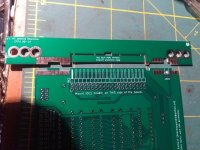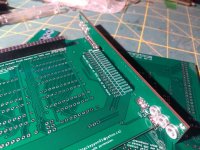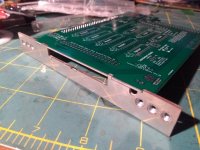Eudimorphodon
Veteran Member
The SX was the first 1000 family machine to have the DMA controller integrated onto the motherboard. I'm guessing Tandy concluded that since they didn't need any "extra" lines to implement the DMA control bus anymore they might as well eliminate their proprietary mapping of those pins.
Thanks to some help in the other thread I was able to solve the particular issue that was vexing me, IE, not actually being able to use IRQ2 for the Realtek 8019AS ethernet card despite the hardware supporting the mapping. As discussed on that thread IRQ2 is itself kind of an interesting edge case for usability; it's fine with XT-vintage hardware and software, but because the AT architecture pirates IRQ2 and attaches the same pin to IRQ9 on the second interrupt controller apparently some software that otherwise runs on an XT, like the "native" packet driver for the Realtek card, won't run with the card on IRQ2 because it makes AT-centric assumptions. Technically it's a stupid bug in the driver that could probably be easily fixed, but I wonder if there are other examples of that sort of thing lurking out there just waiting to bite.
(The workaround here was leveraging the card's NE2000 compatibility and using an 8-bit compatible NE2000 driver that allows manually specifying the I/O and IRQ settings accurately.)
Another thing I've started noticing is there really does seem to be a non-trivial amount of DOS software from the early 90's and later that doesn't like 8088 CPUs but will run on V-20s. So far I've left the 8088 CPU in my HX test rig, and I can confirm that in addition to the current version of Cutemouse being a problem there seems to be an issue with DOS Kermit; a weird, funky issue that's going to force me to break out my second eBay V-20 to absolutely confirm it. Fun stuff!
Thanks to some help in the other thread I was able to solve the particular issue that was vexing me, IE, not actually being able to use IRQ2 for the Realtek 8019AS ethernet card despite the hardware supporting the mapping. As discussed on that thread IRQ2 is itself kind of an interesting edge case for usability; it's fine with XT-vintage hardware and software, but because the AT architecture pirates IRQ2 and attaches the same pin to IRQ9 on the second interrupt controller apparently some software that otherwise runs on an XT, like the "native" packet driver for the Realtek card, won't run with the card on IRQ2 because it makes AT-centric assumptions. Technically it's a stupid bug in the driver that could probably be easily fixed, but I wonder if there are other examples of that sort of thing lurking out there just waiting to bite.
(The workaround here was leveraging the card's NE2000 compatibility and using an 8-bit compatible NE2000 driver that allows manually specifying the I/O and IRQ settings accurately.)
Another thing I've started noticing is there really does seem to be a non-trivial amount of DOS software from the early 90's and later that doesn't like 8088 CPUs but will run on V-20s. So far I've left the 8088 CPU in my HX test rig, and I can confirm that in addition to the current version of Cutemouse being a problem there seems to be an issue with DOS Kermit; a weird, funky issue that's going to force me to break out my second eBay V-20 to absolutely confirm it. Fun stuff!




